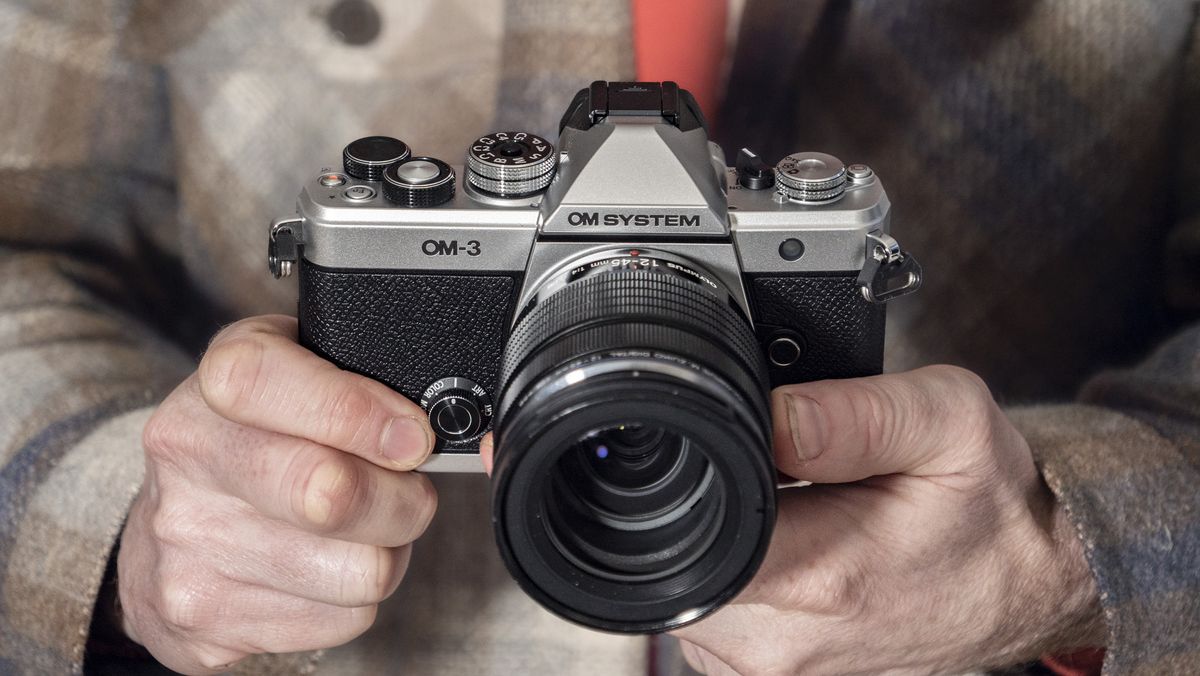Why you can trust TechRadar
We spend hours testing every product or service we review, so you can be sure you’re buying the best. Find out more about how we test.
OM System OM-3: two-minute review
The OM System OM-3 is a stunning camera – just look at it – even if it still stings for Olympus fans that you’re reading OM System on that viewfinder hump.
With its flush faux leather frontage and silver top plate adorned with exposure dials, the OM-3 is as good as retro gets in the camera world. Oh, and there’s also a new color mode dial – that’s so on-trend.
Contrary to what its old-school exterior might suggest, this isn’t a camera that’s stuck in the past, and under the hood the OM-3 packs serious power. Its stacked 20MP Micro Four Thirds sensor delivers blazing-fast burst-shooting performance, up to 50fps with continuous autofocus; intelligent subject-tracking autofocus that works a treat (most of the time); and an array of computational photography modes that make light work of difficult shooting techniques such as focus stacking, which would otherwise require time-consuming edits (even if some of the end results aren’t perfect).
I’m a big fan of what OM System has done with the OM-3. This is its best camera since its acquisition of Olympus in January 2021. From mind-bogglingly impressive in-body image stabilization (I’ve shot sharp images handheld with seconds-long shutter speeds – that’s smartphone night-shot-like skills), to computational photography modes that encourage creative techniques such as long exposures, highly effective autofocus, a wide choice of lenses and a lightweight build (particularly the lenses), I’ve had a blast shooting with the OM-3 over several weeks.
As an everyday camera, most of the fun and creative computational photography modes feel more relevant in the OM-3 than they do in the serious OM-1 II, an alternative that’s the better pick for serious photography such as wildlife.
There’s so much about the OM-3 that just feels right. That said, I wish it was a rangefinder by design, like the Pen-F. Don’t get me wrong: the OM-3 is 2025’s best-looking camera so far. I just think that as an everyday camera that’s best used with small and lightweight lenses, the Pen-F’s smaller rangefinder-style body would have been the better way to go. After all, we already have other OM System cameras with a similar form factor to the OM-3, such as the OM-5.
At $1,999 / £1,699 / AU$3,199 for the body only, the OM-3 is also a pricey camera, especially when you consider that the Fujifilm X-T5 with its 40MP APS-C sensor is around $100 / £100 less. The bottom line for me, however, is that the OM-3 is a camera that I want to shoot with more than most. Its compact and retro design, together with its super-fun shooting modes, have encouraged me to new levels of creativity, and I can’t really put a price on that.
OM System OM-3: price and release date
- The OM-3 costs $1,999 / £1,699 / AU$3,199 body-only
- It’s available bundled with the excellent 12-45mm F4 Pro lens for $2,299 / £1,999 / AU$3,799
- Available to pre-order now, with stock expected late February
On the one hand, the OM-3 is excellent value. It’s the cheapest camera available with a stacked sensor, and packs many of the same features as the pricier OM System OM-1 II flagship. It feels like even better value when bundled with the 12-45mm F4 Pro lens for $300 / £300 / AU$600 more – this is no ordinary kit lens, but a super-sharp and versatile zoom.
However, when you consider rival cameras that you can pick up for around the same money or less, such as the Fujifilm X-T5 with its larger APS-C sensor and 40MP stills, suddenly the OM-3 feels expensive. Its stacked sensor is a costly component and will limit potential price reductions, but I’d hope that the price of OM-3 will settle at around $300 / £250 / AU$500 less than the list price by the end of 2025.
OM System OM-3: specs
|
Sensor: |
20MP Micro Four Thirds stacked CMOS sensor |
|
Video: |
4K 60p / FHD 240p / Slow & Quick modes |
|
Cont. shooting |
50fps with continuous AF |
|
Viewfinder: |
2.36m-dot EVF |
|
LCD: |
3-inch vari-angle touchscreen, 1.62m dots |
|
Battery: |
590 shots |
|
Weight: |
17.5oz / 496g (with memory card and battery, 413g without) |
|
Dimensions: |
139.3 x 88.9 x 45.8mm |
OM System OM-3: design and handling
- A thing of beauty, modelled on 1973’s Olympus OM-1 analog SLR
- Features a handy vari-angle touchscreen and dated 2.36m-dot EVF
- Useful dedicated dials for color modes and computational photography modes
For me, the OM-3 is almost the perfect embodiment of Micro Four Thirds photography; it’s compact and lightweight, highly rugged and attractive, and outright fun.
It’s the camera system that you want to slip into a jacket pocket for a day out or take away for a weekend break, and one that makes you obsessively creative – family and friends who’ve been with me during my review process have had to show extreme levels of patience while I’ve played around with the camera!
The OM-3 feels great in the hand with a small lens attached, and it’ll turns head too, if that seals the deal for you.
I say it’s almost perfect because for an everyday camera like this I think a rangefinder-style body would have been the better design choice – much like 2016’s Pen-F (which we’re told the OM-3 is the natural successor to).
After all, we already have a number of OM System cameras with a raised viewfinder hump, like the OM-5, so why not just squeeze the OM-3’s modest 2.36m-dot EVF unit into the corner of a smaller rangefinder-style camera?
It’s disappointing that we get a dated 2.36m-dot EVF, especially when the OM-1 II has a 5.76m-dot unit with clearer 0.82x magnification. I think the viewfinder placement and dated specs are my main design criticism of the OM-3; otherwise, it’s wider-than-average body allows space for controls to breathe, even if its grip-less body counts out easy handling with larger lenses.
If you like the OM-3’s looks, then you’ll also love how rugged and well built it is. OM System is one of the few camera brands to officially rate its cameras for weather-sealing, and the OM-3 is IP53-rated – that’s decently resistant to dust and water spray. So even though you won’t want to get this lovely-looking camera soaked in a rain shower, it can take it.
I also appreciate the new dedicated button and dials to directly access the OM-3’s color modes and computational photography modes, two creative options that are highly addictive and fun to play with.
You’re spoilt for choice for getting the look you like with four color mode settings, including a dedicated monochrome option, together with a practically infinite degree of customization.
Enthusiast filmmakers are well catered for too, with headphone and microphone ports and USB-C connectivity, although the micro HDMI port won’t impress serious videographers, nor will the camera’s single SD card slot.
Computational photography modes are the closest you get in a mirrorless camera to the smartphone photography experience and features like the Google Pixel’s long-exposure mode.
For example, the Live ND Shooting option can reduce the amount of light the camera gathers, much like an ND lens filter, to enable long-exposure photography – and thanks to the camera’s highly impressive in-body image stabilization you can get this effect when shooting handheld too.
You don’t need a tripod and lens filters to get the long-exposure effect; you can simply take the camera out of your pocket, access one of the ND filter effects, with a max ND64 (6EV) strength, and start shooting. The ease with which you can get creative is what really makes the OM-3 such an addictive camera.
OM System OM-3: features and performance
- Stacked sensor delivers up to 50fps with continuous AF
- Very impressive 590-shot battery life
- Superb image stabilization performance
- Some computational modes take time to process
I have no complaints regarding the OM-3’s features and performance – it’s a surprisingly powerful little camera.
I have to start with its impressive stacked sensor, which delivers incredible speed; there are few cameras that can better its 50fps burst shooting with continuous autofocus, sustained for sequences of around 5-6 seconds before the camera starts to down.
I was able to squeeze slightly longer sequences out of the OM1-II, but the OM3’s performance is more than enough considering the kinds of everyday photography people will likely use it for.
The OM-3’s sensor is also stabilized – and OM System cameras, including predecessors bearing the Olympus name, offer exceptional image stabilization performance. With a steady hand you can shoot sharp images with shutter speeds that are several seconds long, depending on the lens you’re using, and for video it’s entirely possible to shoot smooth-looking clips when on the move.
It’s the impressive stabilization that makes the computational photography modes particularly accessible. For example, employing the Live ND Shooting mode with up to 6EV ND filter effect for long-exposure effects wouldn’t be the same if you had to mount the camera to a tripod. But here we are, able to achieve the effect handheld – see my street and ocean shots in the gallery below.
The same can be said for the High Res Shot mode, which increases resolution to 50MP (with a tripod mount option further increasing detail to 80MP). We also get the latest graduated ND filter effect to reduce the difference in brightness between land and sky by up to 3EV, plus HDR modes.
Some of these modes go some way to nullifying the perceived shortcomings of the OM-3’s 20MP Micro Four Thirds sensor and its lesser dynamic range, while other modes are simply downright fun.
Then there’s the autofocus performance. In some regards it’s exceptional – for example when detecting certain subjects such as birds – and there are sophisticated options for people, such as eye priority that can be further narrowed down to left or right eye priority.
However, there are other scenarios where I found the OM-3’s autofocus less reliable than rival cameras, such as in dim, low-contrast light. Overall though, autofocus performance is very good.
I must also commend the OM-3’s battery life. A decent-sized unit is squeezed into the camera and this delivers a 590-shot capacity, which for a camera this size is pretty impressive.
- Features and performance score: 5/5
OM System OM-3: image and video quality
- Same image quality as the flagship OM-1 II
- 20MP stills, with a 80MP high-res shot mode
- 4K video up to 60fps, and no rolling shutter
Compared to the sensors in full-frame and APS-C cameras from the likes of Sony, Canon, Nikon and Fujifilm, the OM-3’s Micro Four Thirds sensor is smaller, and comes with certain downsides in terms of image quality.
At 20MP, the OM-3 has less resolution than similarly priced rivals, a narrower dynamic range, and relatively modest low-light performance. However, I’m still very happy with the photos and videos that I’ve been able to capture, and for many scenarios the OM3’s image stabilization and computational modes can turn the tables to deliver superb end results.
Not all of the computational modes can be relied upon for every scenario, however. For instance, focus stacking, which is used to increase depth of field and is especially useful for macro photography, exhibits a subtle but spottable ghosting effect in bright subjects, which I particularly noticed in a close-up image of a backlit mushroom.
Creative color
The new color mode dial is worth highlighting too. This offers four options, including monochrome settings, new creative looks with four customizable settings, the long-present Art Filters, plus a Picture mode for a purely customized color profile.
Many of the Art Filters feel a bit dated now, but I still like some of the effects. I think most people will find that one of the new creative looks suits their style, especially given that you can manually tweak the look of each one, with control over curves, shading, sharpness, contrast, and color temperature.
OM System OM-3 sample video
There’s also OM System’s Log color profile for video, HLG, plus a couple of Cinelike color profiles for pleasing straight-out-of-the-camera grades.
Video resolution tops out at 4K with frame rates up to 60fps. If you’re happy to drop to Full HD, then slow-motion 240fps is possible, while a Slow & Quick mode can be utilized for timelapse effects in addition to slow motion.
The OM-3 is a photography-first camera, but it’s entirely possible to get gorgeous-looking and smooth video clips if you know what you’re doing.
Computational photography sample images
For the above long-exposure-effect photos, I set the OM-3 to the Live ND Shooting ND64 setting, which reduces the amount of light the camera takes in by 6EV. This is the maximum strength available, and is sufficient to slow the shutter speed down to seconds long on a gray day, as in the London street and UK coastal images above.
All the above images were captured handheld, and detail in still subjects such as the rock and the ground is perfectly sharp. As such, I’ve felt confident enough to leave my tripod at home for most of this review. Not needing a tripod or ND filters makes creating long-exposure effects a breeze, and I sometimes found myself getting carried away creating such images, much to the annoyance of the people with me at the time!
OM System OM-3 further sample images
- Image and video quality score: 4/5
OM System OM-3: testing scorecard
|
Attributes |
Notes |
Rating |
|---|---|---|
|
Price |
The cheapest way to get a stacked sensor, but rivals at this price point excel in more areas. |
3.5/5 |
|
Design |
Lovely retro feel, complete with robust IO53-rated water-resistant body, but with no grip this is no camera for big lenses. |
4.5/5 |
|
Performance |
A stacked sensor and quad-pixel autofocus make this retro charmer a truly modern performer. |
5/5 |
|
Image and video quality |
Excellent lens choice, and computational photography makes tricky techniques a cinch, but the 20MP sensor doesn’t compare with rivals. |
4/5 |
Should I buy the OM System OM-3?
Buy it if…
Don’t buy it if…
OM System OM-3: also consider
For around $100 / £100 less than the OM-3 less you can pick up the Fujifilm X-T5, which is a highly capable mirrorless camera in a similar mold, sporting a retro body and offering powerful performance. You get a larger APS-C sensor with impressive 40MP resolution and 6K video skills, plus a solid build quality and handling, with neat exposure dials and decent in-body image stabilization.
Read our in-depth Fujifilm X-T5 review
For a bigger outlay, the Nikon Zf is our favorite retro mirrorless camera overall. Like the OM-3 it’s inspired by an analog SLR – in this case the Nikon FM2 – and it’s a compelling Fujifilm rival for retro fans. The full-frame 24MP sensor, superb manual focus-assist tools, easy access to black and white photography, plus Nikon’s best-ever image stabilization, combine to great effect.
Read our in-depth Nikon Zf
If you love the modern tech of the OM-3, including its stacked sensor, computational photography smarts, and superb tracking autofocus, you’ll get all of that with the costlier OM-1 II, which is better suited to wildlife and action photography thanks to its pronounced grip and comfortable handling with large lenses. It offers the same image quality and performance as the OM-3, plus it costs more, but you get a better design for demanding pursuits.
Read our in-depth OM System OM-1 II review
How I tested the OM System OM-1 II
- OM System loaned me the OM-3 with the 12-45mm F4 Pro lens for several weeks
- I also used some of my own OM System gear with the camera – the 90mm F3.5 Macro lens and tiny 45mm F1.8 portrait lens
- I put the OM-3 through its paces in many and varied photo and video scenarios, and tried out the computational photography modes
I shot with the OM-3 for several weeks, together with the 12-45mm F4 Pro, 90mm F3.5 Macro, and 45mm F1.8 lenses. I was also using the OM-1 at the same time, which has enabled me to make comparisons between the handling of the two types of OM System designs.
The camera and lenses were with me come rain or shine, both day and night, during which time I tested the gear regularly, including the OM-3’s photography modes, color profiles, and computational photography smarts.
I tested the High Res Shot and Long Exposure modes, both handheld and with the camera mounted to a tripod. I’ve also tested burst shooting performance, with standard cameras settings that we use for all of TechRadar’s camera tests.
First reviewed February 2025
Read the full article here














